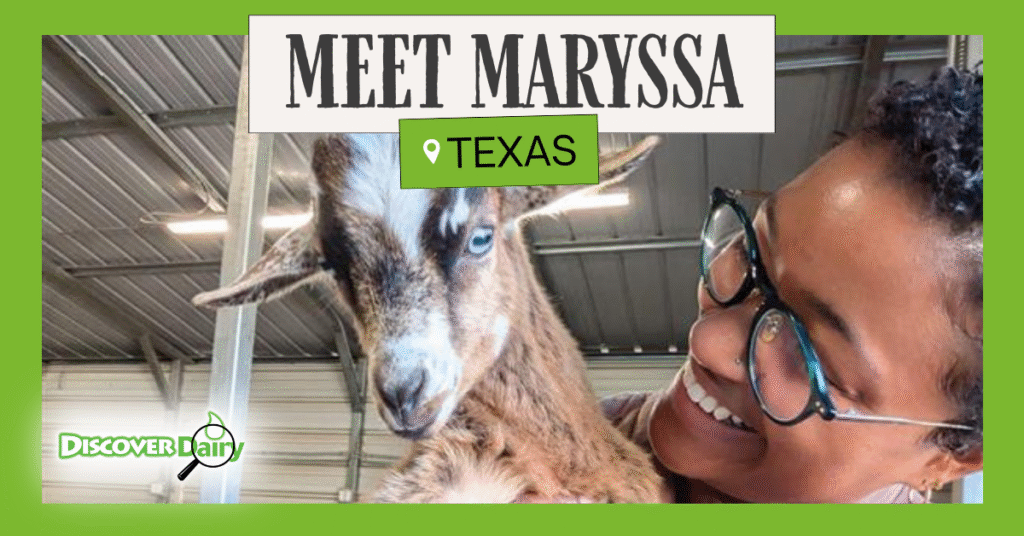Meet Maryssa: Texas Elementary Teacher Who Supports Students With Agriculture Therapy Program

This story is part of a series of “meet & greets” with individuals who use our Adopt a Cow program to inspire you with the endless ways you can incorporate the program in the classroom and beyond!
Maryssa Adams teaches pre-k through 5th grade in a Title 1, urban school district in Texas. After noticing increasing levels of stress, anxiety and behavioral issues in students, her campus decided to create an agriculture therapy program. Discover Dairy’s “Adopt a Cow” program was the perfect complement to some of the concepts they teach students through the ag therapy program.
We sat down for a quick Q&A with Maryssa to learn more about how agriculture education is empowering her students.
How did the ag therapy program come about?
It all started with my love for animals and having been privileged enough to experience the healing they bring firsthand. The increasing levels of stress, anxiety, and behavioral issues in students was also something that we just couldn’t ignore. Our campus has always been really big about supporting the “whole child” and emphasizing the importance of social and emotional development. It just seemed like tactile and experiential learning was the way to help kiddos truly thrive.
What does the program involve?
Gardening and Plant Care: Students plant, water, weed, and harvest fruits, vegetables, herbs, and flowers. Children learn about life cycles, seasons, and sustainability.
Animal-Assisted Activities: Interaction with small farm animals (e.g., chickens and goats) Doing daily care tasks like water, food, habitat upkeep to teach empathy, responsibility, compassion, and caregiving.
Many tasks are done in pairs or small groups to foster communication, cooperation, and shared responsibility.
How are students benefitting from the ag therapy program?
Working with plants and animals improves empathy, responsibility, and teamwork. These are foundational skills for emotional intelligence and future success.
Students have shown an enhanced self-esteem and a sense of accomplishment, along with resilience and patience, through nurturing living things. Stress and anxiety has been reduced with nature based activities having calming effects, helping students feel more relaxed and focused.
There are also numerous academic benefits such as boosting engagement, enhancing understanding, making learning more meaningful and memorable, and supporting differentiated learning.
How does the Adopt a Cow program connect to what you’re doing in the ag therapy program?
We started with a welcome party where students got to “meet” our adopted cow, Aspen. The biggest piece was, with each growth update, we connected to how all living things grow and experience change. Seeing Aspen grow throughout the year was huge in helping our students reflect on their own personal growth.
Additionally, students began to understand what Aspen needs to thrive, and realized that we are not so different when it comes to food, safety, care, etc. This was the first year for us using the program, but it won’t be the last. We loved it!
Were there any creative ways you incorporated the Adopt a Cow program into the classroom? Any fun memories your students made?
We had a Meet Your Cow Day, where we shared photos, fun facts, etc. and let students write letters, draw pictures, and create a sort of “Cow Diaries”. We used this regularly for students to reflect on what they learned, express how they felt about the update, take note of something they noticed or wondered, etc.
My interactive bulletin board was a favorite, too. Students would submit guesses on calf growth, submit questions, make artwork (my calf and me), etc.
I also laminated photos of Aspen for students to keep in their self-regulation folder. It was honestly the best seeing them pull it out, look at it, take a deep breath, and calm themselves down.
Why do you think it’s important for students to learn about agriculture and where their food comes from?
When students understand how food is grown and produced, they’re more likely to make informed, healthy choices. They begin to appreciate the value of fresh, whole foods and are more willing to try fruits and vegetables—especially ones they’ve grown themselves.
Learning where food comes from fosters gratitude for farmers, animals, and the natural processes that sustain us. It teaches respect for the hard work and time involved in growing and producing food—not just grabbing it off a shelf.
Agriculture naturally integrates science, math, reading, and social studies into real-world contexts. It answers kids’ common question: “Why do I need to learn this?”—by giving them practical, meaningful examples.
As issues like climate change, food security, and sustainability become more critical, students who understand agriculture will be better equipped to contribute solutions.
It can also spark interest in future careers in science, environmental studies, nutrition, veterinary care, and beyond.
Agriculture education isn’t just about farming — it’s about empowering kids to understand, respect, and engage with the world around them in a thoughtful, grounded way.
—
The Adopt a Cow Program is now open for enrollment for the 2025 school year! Click here to learn more and adopt a cow for your classroom today. The program, which impacted more than 1.7 million students last school year, is free thanks to support from Discover Dairy partners and donors.
Discover Dairy is an educational series managed by the Center for Dairy Excellence Foundation of Pennsylvania in partnership with American Dairy Association Northeast, American Dairy Association Indiana, Midwest Dairy, The Dairy Alliance, Dairy Farmers of Wisconsin, Dairy Management West, Dairy West, New England Dairy, Dairy Farmers of Washington, American Dairy Association Mideast, Dairy Council of Florida, United Dairy Industry of Michigan, Maine Dairy and Nutrition Council, and Oregon Dairy Council.